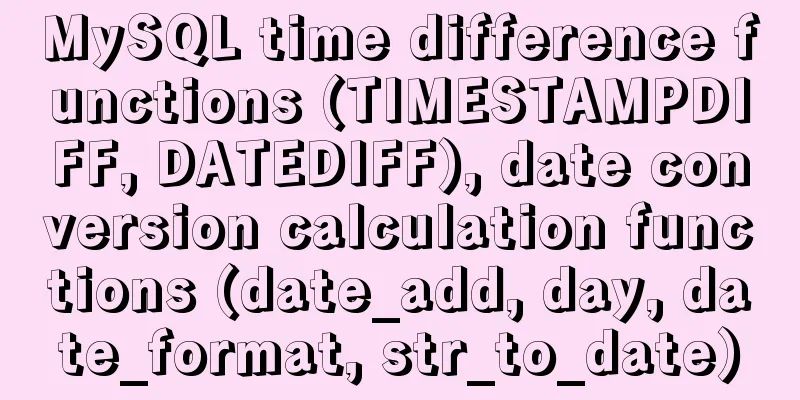How to install MySQL 5.7.28 binary mode under CentOS 7.4

|
Linux system version: CentOS7.4 MySQL version: 5.7.28 There are three installation methods on the Linux platform: RPM package, binary package, and source package. This article mainly uses the RPM package as an example to introduce how to install MySQL on the Linux platform. Download address: https://cdn.mysql.com//Downloads/MySQL-5.7/mysql-5.7.28-linux-glibc2.12-x86_64.tar.gz
The specific installation steps are as follows: (1) First uninstall mariadb, otherwise it will conflict with the library required for installing mysql: [root@localhost ~]# rpm -qa | grep mariadb mariadb-libs-5.5.56-2.el7.x86_64 [root@localhost ~]# rpm -e --nodeps mariadb-libs-5.5.56-2.el7.x86_64 (2) Log in to the system as the root user, add the mysql user and group, and install the database under this user: [root@localhost ~]# groupadd mysql [root@localhost ~]# useradd -r -g mysql -s /bin/false mysql (3) Prepare the data directory Taking /app/data as an example, it is recommended to use a logical volume [root@localhost ~]# mkdir -p /app/data [root@localhost ~]# chown mysql.mysql /app/data/ [root@localhost ~]# chmod 750 /app/data (4) Prepare binary files: [root@localhost ~]# tar xvf mysql-5.7.28-linux-glibc2.12-x86_64.tar.gz -C /usr/local/ root@localhost ~]# cd /usr/local [root@localhost local]# ln -sv mysql-5.7.28-linux-glibc2.12-x86_64 mysql 'mysql' -> 'mysql-5.7.28-linux-glibc2.12-x86_64' (5) Initialize MySQL: [root@localhost ~]# cd /usr/local/mysql [root@localhost mysql]# bin/mysqld --initialize --user=mysql --basedir=/usr/local/mysql --datadir=/app/data 2019-11-03T09:47:18.263716Z 0 [Warning] TIMESTAMP with implicit DEFAULT value is deprecated. Please use --explicit_defaults_for_timestamp server option (see documentation for more details). 2019-11-03T09:47:19.059462Z 0 [Warning] InnoDB: New log files created, LSN=45790 2019-11-03T09:47:19.140866Z 0 [Warning] InnoDB: Creating foreign key constraint system tables. 2019-11-03T09:47:19.207569Z 0 [Warning] No existing UUID has been found, so we assume that this is the first time that this server has been started. Generating a new UUID: ed1cd8ec-fe1e-11e9-8c9c-000c29f8617a. 2019-11-03T09:47:19.209181Z 0 [Warning] Gtid table is not ready to be used. Table 'mysql.gtid_executed' cannot be opened. 2019-11-03T09:47:19.646366Z 0 [Warning] CA certificate ca.pem is self signed. 2019-11-03T09:47:20.056792Z 1 [Note] A temporary password is generated for root@localhost: rY-6f??#!<zO Among them, --basedir mysql base directory --datadir mysql data storage directory, and created a temporary password for the root user: rY-6f??#!<zO (6) Enable SSL connection: [root@localhost mysql]# bin/mysql_ssl_rsa_setup 2019-11-03 23:09:55 [ERROR] Failed to access directory pointed by --datadir. Please make sure that directory exists and is accessible by mysql_ssl_rsa_setup. Supplied value : /usr/local/mysql/data [root@localhost mysql]# bin/mysql_ssl_rsa_setup --datadir=/app/data If no parameter is added after the command, an error is reported. If --datadir is added, no error is reported. (7) Edit the configuration file, save and exit: [root@localhost mysql]# vim /etc/my.cnf [mysqld] #GENERAL datadir=/app/data socket=/app/data/mysql.sock user=mysql default-storage-engine=InnoDB [mysqld_safe] log-error=/app/data/mysql-error.log pid-file=/app/data/mysqld.pid [client] socket=/app/data/mysql.sock (8) Start MySQL: [root@localhost mysql]# bin/mysqld_safe --user=mysql & (9) Configure environment variables: [root@localhost ~]# vim /etc/profile #Add the following line export PATH=$PATH:/usr/local/mysql/bin [root@localhost ~]# source /etc/profile (10) Set the startup: [root@localhost mysql]# cp support-files/mysql.server /etc/init.d/mysql.server [root@localhost mysql]# chkconfig --add mysql.server (11) Test login success: [root@localhost ~]# mysql -uroot -p Enter password: Welcome to the MySQL monitor. Commands end with ; or \g. Your MySQL connection id is 2 Server version: 5.7.28 Copyright (c) 2000, 2019, Oracle and/or its affiliates. All rights reserved. Oracle is a registered trademark of Oracle Corporation and/or its affiliates. Other names may be trademarks of their respective owners. Type 'help;' or '\h' for help. Type '\c' to clear the current input statement. mysql> The above is the full content of this article. I hope it will be helpful for everyone’s study. I also hope that everyone will support 123WORDPRESS.COM. You may also be interested in:
|
<<: JavaScript object built-in objects, value types and reference types explained
Recommend
How to use Vue3 asynchronous data loading component suspense
Table of contents Preface Creating Components Sum...
About the configuration problem of MyBatis connecting to MySql8.0 version
When learning mybatis, I encountered an error, th...
HTML hyperlink style (four different states) setting example
Copy code The code is as follows: <style type=...
How to generate mysql primary key id (self-increment, unique and irregular)
Table of contents 1. Use the uuid function to gen...
How to change the dot in the WeChat applet swiper-dot into a slider
Table of contents background Target Effect Ideas ...
10 Popular Windows Apps That Are Also Available on Linux
According to data analysis company Net Market Sha...
Steps to enable MySQL database monitoring binlog
Preface We often need to do something based on so...
Vue implements online preview of PDF files (using pdf.js/iframe/embed)
Preface I am currently working on a high-quality ...
Supplementary article on front-end performance optimization
Preface I looked at the previously published arti...
An example of the execution order between the href jump and onclick of the html hyperlink a tag
The execution relationship between the href jump ...
A brief discussion on the design and optimization of MySQL tree structure tables
Preface In many management and office systems, tr...
Quickly solve the problem of garbled characters and jump lines in mysql exported scv files
Due to work reasons, it is often not possible to ...
HTML table tag tutorial (27): cell background image attribute BACKGROUND
We can set a background image for the cell, and w...
Install OpenSSH on Windows and log in to the Linux server by generating an SSH key
The full name of SSH is Secure SHell. By using SS...
How to solve the 10060 unknow error when Navicat remotely connects to MySQL
Preface: Today I want to remotely connect to MySQ...










